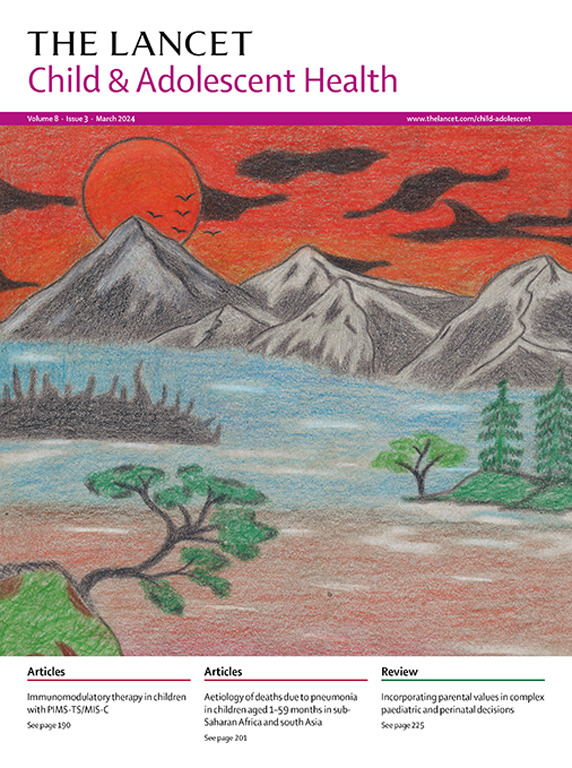暴露于艾滋病毒但未感染的儿童的成长:系统回顾和荟萃分析
IF 19.9
1区 医学
Q1 PEDIATRICS
引用次数: 0
摘要
背景:目前缺乏汇总分析,总结hiv暴露的未感染儿童(HEU)与未暴露儿童(HU)的长期生长结局。我们的目的是总结关于增长结果的现有文献。方法对HEU患儿与HU患儿的60个月生长结局(身高与年龄比值Z评分[LAZ]、体重与年龄比值Z评分[WAZ]、体重与身高比值Z评分[WLZ]、头围与年龄比值Z评分[HCAZ]、发育迟缓[LAZ<;−2]、消瘦[WLZ<;−2]、体重不足[WAZ<;−2]、小头畸形[HCAZ<;−2])的已发表文献进行系统回顾和荟萃分析。检索了1989年1月1日至2022年12月31日的Medline、EMBASE、Cochrane Library、WHO Global Index Medicus和Web of Science。随机对照试验和队列研究比较了HEU患儿和HU患儿的生长情况。使用随机效应和固定效应荟萃分析汇总特定研究的估计值。结果按年龄分层(出生;0 - 5个月;11个月;12 - 17个月;18 - 23个月;以及24-60个月)和抗逆转录病毒治疗(ART)期间(ART前[2003年以前];ART[2003年起])。本研究已注册为PROSPERO, CRD42018091762。研究结果:纳入28项研究;在非洲进行了25例(90%),在抗逆转录病毒治疗期间进行了23例(82%),报告了来自15个国家的11794例高毒血症儿童和23826例高毒血症儿童的生长结果。在ART前和ART期间的所有年龄段,HEU儿童的LAZ明显低于HU儿童。在抗逆转录病毒治疗期间,除0-5个月外,HEU儿童在所有年龄段都更有可能发育迟缓。在抗逆转录病毒治疗前,6-11个月至18-23个月的高浓血症儿童以及抗逆转录病毒治疗期间的所有年龄段WAZ均显著降低。HEU患儿出生时体重不足的几率显著高于HU患儿;这种差异一直持续到两岁。除24-60个月外,所有年龄的HEU患儿ART前和ART HCAZ均显著降低,尽管异质性很高。各组间WLZ无差异。与抗逆转录病毒治疗前相比,在抗逆转录病毒治疗期间,HEU儿童和HU儿童之间的差异更为明显,尤其是在更小的年龄。高浓血症的孩子比高浓血症的孩子有更多的生长迟缓,这种情况在出生时就存在,并持续到前24个月。这些增长差距在抗逆转录病毒治疗期间仍然很明显。促进健康成长的干预措施可能需要从产前就开始。本文章由计算机程序翻译,如有差异,请以英文原文为准。
Growth of children who are HIV-exposed but uninfected: a systematic review and meta-analysis
Background
Pooled analyses summarising long-term growth outcomes in children who are HIV-exposed uninfected (HEU) compared with children who are HIV-unexposed (HU) are lacking. We aimed to summarise the existing literature on growth outcomes.
Methods
We did a systematic review and meta-analysis of published literature on 60-month growth outcomes (length-for-age Z score [LAZ], weight-for-age Z score [WAZ], weight-for-length Z score [WLZ], head circumference-for-age Z score [HCAZ], stunting [LAZ<−2], wasting [WLZ<−2], underweight [WAZ<−2], and microcephaly [HCAZ<−2]) in children who were HEU compared with children who were HU. Medline, EMBASE, Cochrane Library, WHO Global Index Medicus and Web of Science were searched from Jan 1, 1989 to Dec 31, 2022. Randomised controlled trials and cohort studies comparing growth in children who were HEU versus children who were HU were included. Study-specific estimates were pooled by use of random-effects and fixed-effect meta-analysis. Results were stratified by age (birth; 0–5 months; 6–11 months; 12–17 months; 18–23 months; and 24–60 months) and antiretroviral therapy (ART) period (pre-ART [before 2003]; ART [2003 onwards]). This study is registered with PROSPERO, CRD42018091762.
Findings
28 studies were included; 25 (90%) were done in Africa and 23 (82%) in the ART period, reporting growth outcomes on 11 794 children who were HEU and 23 826 children who were HU from 15 countries. Across all ages in the pre-ART and ART periods, children who were HEU had significantly lower LAZ compared with children who were HU. In the ART period, children who were HEU were more likely to be stunted at all ages except for 0–5 months. Pre-ART, significantly lower WAZ was found in children who were HEU from 6–11 months to 18–23 months, and at all ages during the ART period. Children who were HEU had significantly higher odds of underweight at birth than children who were HU; this difference persisted to age 2 years. Pre-ART and ART HCAZ were significantly lower for children who were HEU at all ages, except for 24–60 months, even though heterogeneity was high. No differences in WLZ were found between groups. Differences between children who were HEU and children who were HU tended to be more pronounced during the ART period compared with the pre-ART period, particularly at younger ages.
Interpretation
Children who are HEU have more growth faltering than children who are HU, which is present at birth and persists over the first 24 months. These growth disparities remain evident during the ART period. Interventions to promote healthy growth probably need to start antenatally.
Funding
None.
求助全文
通过发布文献求助,成功后即可免费获取论文全文。
去求助
来源期刊

Lancet Child & Adolescent Health
Psychology-Developmental and Educational Psychology
CiteScore
40.90
自引率
0.80%
发文量
381
期刊介绍:
The Lancet Child & Adolescent Health, an independent journal with a global perspective and strong clinical focus, presents influential original research, authoritative reviews, and insightful opinion pieces to promote the health of children from fetal development through young adulthood.
This journal invite submissions that will directly impact clinical practice or child health across the disciplines of general paediatrics, adolescent medicine, or child development, and across all paediatric subspecialties including (but not limited to) allergy and immunology, cardiology, critical care, endocrinology, fetal and neonatal medicine, gastroenterology, haematology, hepatology and nutrition, infectious diseases, neurology, oncology, psychiatry, respiratory medicine, and surgery.
Content includes articles, reviews, viewpoints, clinical pictures, comments, and correspondence, along with series and commissions aimed at driving positive change in clinical practice and health policy in child and adolescent health.
 求助内容:
求助内容: 应助结果提醒方式:
应助结果提醒方式:


